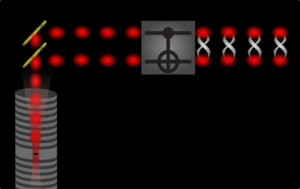Quantum light manipulation
Indistinguishable single-photons can be used in linear optical schemes to implement quantum logic gates and perform non-classical operations. In this context, bright, pure and indistinguishable quantum dot single-photon sources can speed up the gate operation by orders of magnitude and potentially strongly increase the number of photons involved in quantum operations.
On chip quantum light manipulation

A boson sampling device is a quantum machine expected to perform tasks intractable for a classical computer, yet requiring minimal non-classical resources as compared to full-scale quantum computers. Photonic implementations to date employed sources based on inefficient processes that only simulate heralded single-photon statistics when strongly reducing emission probabilities. We performed a boson sampling device operated with a bright solid-state source of highly-pure single-photon Fock states: the emission from an efficient and deterministic quantum dot-micropillar system is demultiplexed into three partially-indistinguishable single-photons, with purity 1−g (2)(0) of 0.990 ± 0.001, interfering in a 6×6 linear optics network. Our demultiplexed source is orders-of-magnitude brighter than current heralded multi-photon sources based on spontaneous parametric down-conversion, allowing us to complete the BosonSampling experiment 100 times faster than previous equivalent implementations.
More recent contributions have focused on the generation of ever larger implementations of entangled states:
Quantum light manipulation in fibered systems

Cluster states, composed of multiple entangled photons, are essential states for the scaling of optical quantum computing. In our lab, we have performed the generation of polarization-encoded, individually-addressable photons in linear cluster states occupying a single spatial mode by employing a single entangling-gate in a fiber loop configuration to sequentially entangle an ever-growing stream of photons. This apparatus enabled the generation of linear cluster states up to four photons in a single-mode fiber.
Entangling photon gates

A quantum controlled NOT (C-NOT) gate is a crucial element for quantum information processing. It is a two-qubit gate that flips the state of a target qubit depending on the state of a control one. The quantum capability of the gate allows creating an entangled two-qubit output state from independent input qubits. We use an ultrabright solid-state single photon source made by inserting a single quantum dots in a pillar microcavity. The truth table of the gate is measured in rectilinear basis and shows a probability of obtaining the correct output of 68% for a source brightness of 0.55 collected photon per pulse. By setting the control photon in diagonal basis, we show that the two output photons can be entangled. The fidelity to the Bell state is above the 0.5 limit for quantum correlation for a source brightness of 50% and reaches 71% for short time delays.